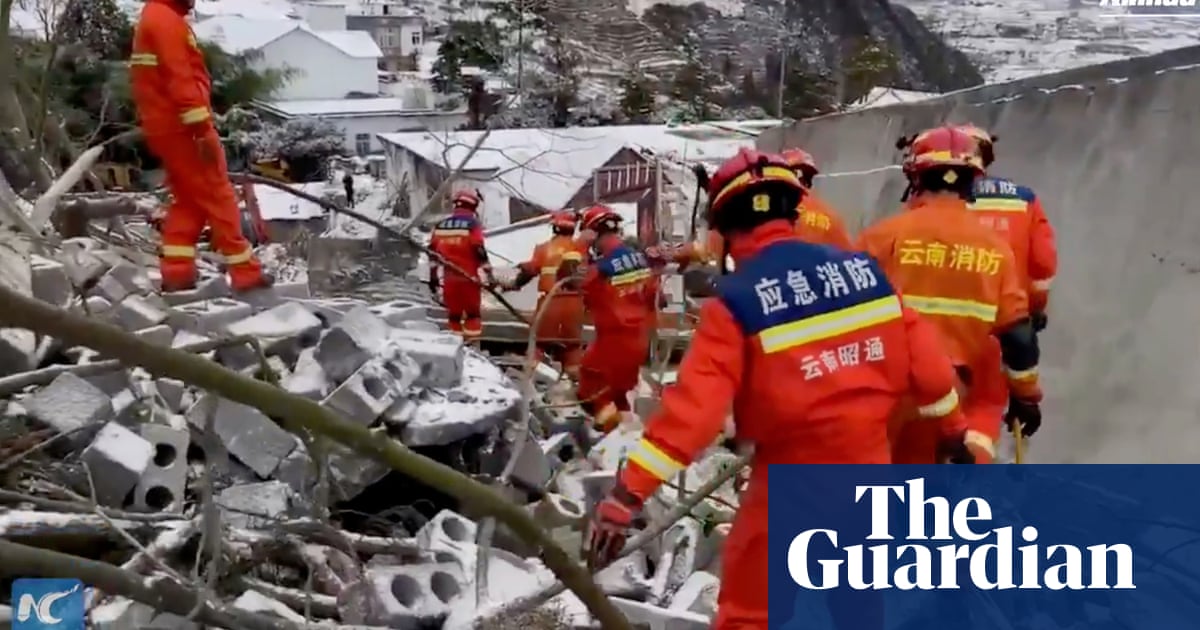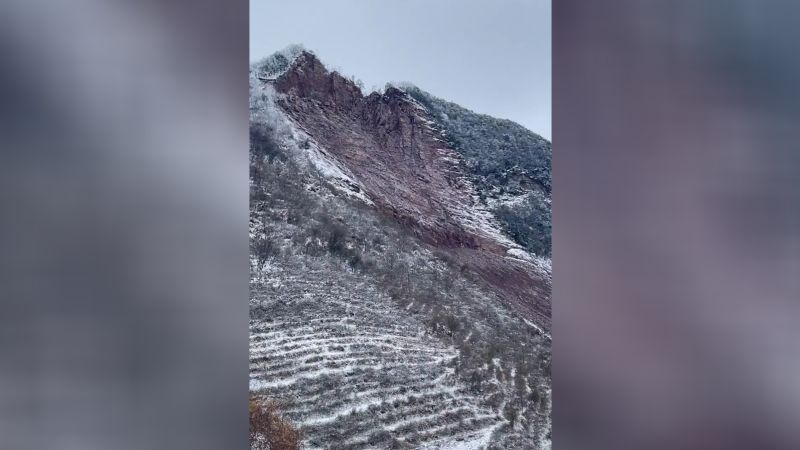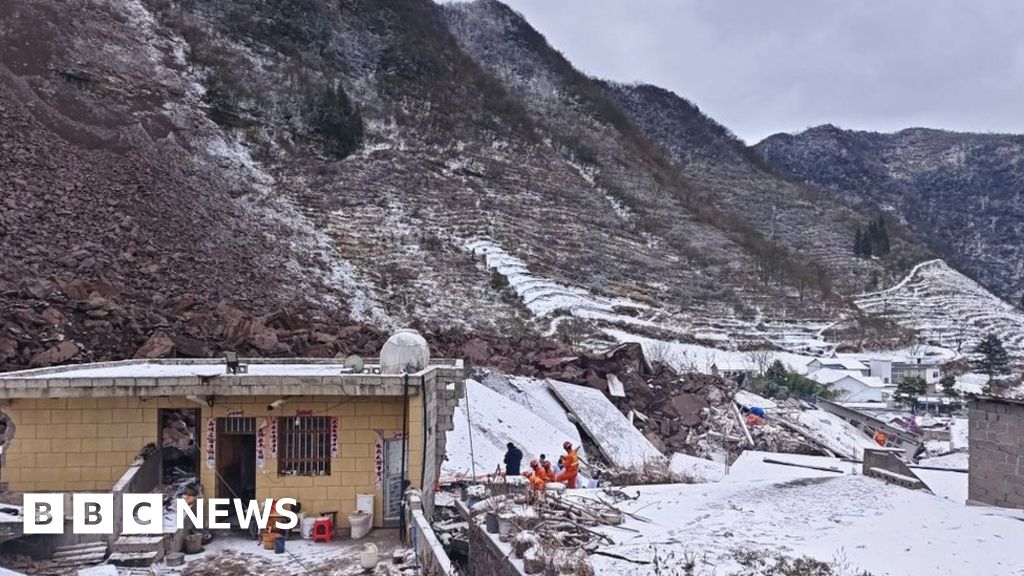A landslide in southwestern China's mountainous Yunnan province on Monday buried 47 people, killing at least eight and forcing the evacuation of hundreds. The disaster struck just before 6 a.m., burying dozens of houses in Liangshui village, near the borders with Sichuan and Guizhou provinces.
47 Killed in Landslide in Yunnan Province, China
Liangshui village, Yunnan province SwitzerlandA landslide in southwestern China's mountainous Yunnan province on Monday buried 47 people, killing at least eight and forcing the evacuation of hundreds. The disaster struck just before 6 a.m., burying dozens of houses in Liangshui village, near the borders with Sichuan and Guizhou provinces.





Confidence
80%
Doubts
- It is not clear if there were any warning signs prior to the landslide.
Sources
66%
China: At least eight dead, dozens missing in Yunnan landslide
BBC News Site: https://www.bbc.com/news/world-us-canada-68702081, About Us URL: https://www.bbc.com/aboutthebbc/ By Fan Monday, 22 January 2024 11:22Unique Points
- Rescuers have recovered the bodies of eight people as the race to reach at least 47 others buried in a landslide in southwestern China on Monday continues.
- The cause of the landslide remains unclear, but the remote, mountainous region is prone to them
- One man was pulled from the rubble shortly after 11 a.m. local time.
Accuracy
- The cause of the landslide remains unclear
- One resident told local news outlet Jimu News that the landslide happened while many people were still asleep on Monday morning
- `President Xi Jinping has ordered an 'all-out' rescueĴ in the area which is experiencing sub-zero temperatures
Deception (50%)
The article contains several examples of deceptive practices. Firstly, the author uses sensationalism by stating that at least eight people have died and dozens are still missing after a landslide struck China's southwestern province of Yunnan. This statement is not supported by any evidence presented in the article and could be seen as an attempt to manipulate readers into believing that this disaster is more severe than it actually is. Secondly, the author uses selective reporting by only mentioning one incident from January 2013 while ignoring other incidents of landslides in Yunnan province. This creates a false impression that this particular incident was unique and not part of a larger pattern. Thirdly, the article does not provide any evidence to support the claim that sub-zero temperatures were experienced at the site during rescue operations.- The article only mentions one incident from January 2013 while ignoring other incidents of landslides in Yunnan province, which creates a false impression that this particular incident was unique and not part of a larger pattern.
- The statement 'At least eight people have died and dozens are still missing after a landslide struck China's southwestern province of Yunnan.' is an example of sensationalism as it exaggerates the severity of the disaster without providing any evidence to support this claim.
Fallacies (75%)
The article contains several fallacies. Firstly, the author uses an appeal to authority by stating that President Xi Jinping has ordered an 'all-out' rescue in the area. This implies that his order is a reliable source of information and should be taken as fact without question. However, it is important to note that this statement does not provide any evidence or context for why he made such an order, nor does it necessarily mean that his decision was based on sound judgment or expertise. Secondly, the author uses inflammatory rhetoric by describing the landslide as a 'big earthquake' and stating that it felt like one. This is likely to create fear and panic in readers who may not have experienced an actual earthquake before. Thirdly, there are several instances of dichotomous depiction throughout the article, such as when it states that most residents were either elderly or children. This creates a false sense of opposition between these two groups and implies that they are mutually exclusive, which is not necessarily true in reality.- President Xi Jinping has ordered an 'all-out' rescue in the area
- The landslide felt like a big earthquake
- Most residents were either elderly or children
Bias (75%)
The article contains a statement that implies the landslide was caused by natural factors. However, it is not clear if this is true or if there were any human activities involved in causing the landslide.- > The cause of the landslide remains unclear,
Site Conflicts Of Interest (50%)
The author has a conflict of interest with the topic 'President Xi Jinping' as they are reporting on an all-out rescue in the area which is experiencing sub-zero temperatures.Author Conflicts Of Interest (50%)
The author has a conflict of interest on the topic of China as they are reporting for BBC News. The article mentions President Xi Jinping and his involvement in the rescue efforts which could compromise their ability to report objectively.
70%
At least 8 dead after landslide buries dozens in southwest China in freezing winter temperatures
CNN News Site: In-Depth Reporting and Analysis with Some Financial Conflicts and Sensational Language Nectar Gan, Monday, 22 January 2024 07:27Unique Points
- Rescuers have recovered the bodies of eight people as the race to reach at least 47 others buried in a landslide in southwestern China on Monday continues.
- More than 300 rescue workers were deployed along with dozens of fire engines and earth-moving equipment.
- One man was pulled from the rubble shortly after 11 a.m. local time.
Accuracy
- The cause of the landslide remains unclear, but the remote, mountainous region is prone to them
- In January 2013, at least 18 people were killed in a landslide in the same county
Deception (50%)
The article is deceptive in several ways. Firstly, the title implies that at least 8 people have died when it's not clear if all of them are dead or just missing. Secondly, the author uses sensationalism by describing the landslide as a 'race to reach at least 47 others buried'. This is misleading because there is no indication that anyone else was actually buried in addition to those already found. Thirdly, the article quotes CCTV reporting on rescue efforts without disclosing its source or bias. Lastly, the author uses selective reporting by focusing only on the number of people affected and not providing any context about why this landslide occurred.- The title implies that at least 8 people have died when it's not clear if all of them are dead or just missing.
Fallacies (70%)
The article contains several fallacies. The first is an appeal to authority when it states that the rescue team found eight missing people and all of them have no sign of life. This statement assumes that the rescue team's findings are accurate without providing any evidence or alternative explanations for their conclusions.- Rescue team found eight missing people, all of whom have no sign of life.
Bias (100%)
None Found At Time Of Publication
Site Conflicts Of Interest (0%)
The article by Nectar Gan and Wayne Chang on CNN reports on a landslide in Yunnan province that killed at least eight people. The authors have conflicts of interest with the topic of China as they are part of a rescue team sent to help those affected by the disaster.- The article mentions that Nectar Gan and Wayne Chang were part of a rescue team sent to Yunnan province after the landslide. This indicates that they have personal ties with the topic of China, which could compromise their ability to report objectively.
Author Conflicts Of Interest (100%)
None Found At Time Of Publication
79%
Landslide in mountainous southwestern China buries 47 people
The Associated Press News Monday, 22 January 2024 03:22Unique Points
- A landslide in southwestern China's mountainous Yunnan province early on Monday buried 47 people
- Rescue efforts were underway to find victims buried in 18 separate houses
- Two bodies were pulled from the rubble and Luo Dongmei survived and was relocated to a school building by local authorities
Accuracy
No Contradictions at Time Of Publication
Deception (50%)
The article is deceptive in several ways. Firstly, it states that the landslide buried dozens of people but does not specify how many exactly were killed or injured. This statement is misleading as it implies a higher death toll than what was actually reported by the authorities. Secondly, the article mentions that rescue efforts are underway to find victims buried in 18 separate houses, which suggests that there may be more people missing than what was initially stated. However, this information is not confirmed and could just be speculation on behalf of the author or source. Lastly, the article quotes a survivor who claims she heard her sister and aunt were trapped in the landslide but does not provide any evidence to support this claim.- The statement 'buried dozens' is misleading as it implies a higher death toll than what was actually reported by the authorities.
- 'Luo Dongmei claims she heard her sister and aunt were trapped in the landslide' is not supported by any evidence.
- Rescue efforts are underway to find victims buried in 18 separate houses, which suggests that there may be more people missing than what was initially stated.
Fallacies (75%)
The article contains several fallacies. The first is an appeal to authority when it states that the landslide in southwestern China's mountainous Yunnan province early Monday buried dozens and forced the evacuation of hundreds. This statement implies that there are no other sources for this information, which is not true as there may be multiple reports from different news outlets or experts on the subject. The second fallacy found is inflammatory rhetoric when it states thatBias (85%)
The article reports on a landslide in southwestern China that buried 47 people and forced the evacuation of hundreds. The author does not provide any political or religious bias, but there is an example of monetary bias as the article mentions economic losses caused by natural disasters in China. Additionally, there are examples of ideological bias as the article discusses how landslides are not uncommon in China and provides statistics on deaths and missing persons from last year's natural disasters. The author also uses language that depicts one side as extreme or unreasonable when describing the impact of natural disasters on people's lives.- At least 70 people were killed in landslides last year, including more than 50 at an open pit mine in China’s Inner Mongolia region
- Nearly 1,000 people were injured and more than 14,000 homes were destroyed
- The cause of the landslide wasn’t immediately known
Site Conflicts Of Interest (100%)
None Found At Time Of Publication
Author Conflicts Of Interest (0%)
None Found At Time Of Publication
76%
Landslide in Southern China Buries Dozens and Sends Hundreds Fleeing
The Name Of The NZ Prefix. I PWA NZI.P.Was Dropped. Vivian Wang Monday, 22 January 2024 06:43Unique Points
- The landslide occurred just before 6 a.m. on Monday, hitting two small villages in Yunnan Province.
- Rescue efforts were underway to find victims buried in 18 separate houses.
- Two bodies were pulled from the rubble and Luo Dongmei survived and was relocated to a school building by local authorities.
Accuracy
No Contradictions at Time Of Publication
Deception (30%)
The article is deceptive in several ways. Firstly, the title of the article implies that a landslide occurred and buried dozens of people. However, upon reading further it becomes clear that only eight people died and another 39 were under the rubble. This discrepancy between what was stated in the title and what is actually reported in the body of the article is deceptive.- The title implies a landslide occurred which buried dozens of people, but upon reading further it becomes clear that only eight people died and another 39 were under the rubble.
Fallacies (85%)
The article contains several fallacies. The first is an appeal to authority when it states that the landslide occurred just before 6 a.m., without providing any evidence or context for this claim.- > Advertisement <br> SKIP ADVERTISEMENT
Bias (100%)
None Found At Time Of Publication
Site Conflicts Of Interest (100%)
None Found At Time Of Publication
Author Conflicts Of Interest (50%)
The author has a conflict of interest on the topic of landslides in China as they are reporting for The New York Times which is owned by News Corporation. This company also owns several mining companies that operate in areas prone to landslides.
77%
China landslide kills eight and buries dozens in Yunnan province
theguardian.com Article URL: https://www.theguardian.com/world/2024/feb/13/ pakistan-·coalition-·agrees-to-form-government Monday, 22 January 2024 10:54Unique Points
- Forty-seven people were buried in a landslide
- Eight people were found without vital signs.
- Landslides are common in Yunnan due to steep mountain ranges butt against the Himalayan plateau. The disaster occurred in a rural area surrounded by towering snowy peaks.
Accuracy
- The cause of the landslide remains unclear.
- Rescuers have recovered the bodies of eight people as the race to reach at least 47 others buried in a landslide in southwestern China on Monday continues.
Deception (50%)
The article is deceptive in several ways. Firstly, the author does not disclose their sources and only quotes from China Central Television (CCTV), which raises questions about bias and reliability. Secondly, the article reports that eight people were found without vital signs but does not provide any further information on how they died or if there was any investigation into their deaths. This is a lie by omission as it implies that the landslide caused these deaths when in fact more information is needed to determine this. Thirdly, while the article mentions other natural disasters that occurred in China recently, it does not provide any context on how they are related to the current landslide disaster or if there is a pattern of such events happening frequently. This selective reporting creates a false sense of urgency and importance for readers without providing all necessary information.- The article quotes from CCTV as its source but does not disclose any other sources, raising questions about bias and reliability.
Fallacies (80%)
The article contains several fallacies. The first is an appeal to authority when it states that about 18 households were buried and more than 200 people evacuated without providing any evidence or sources for these numbers. Additionally, the statement that eight people were found without vital signs may be misleading as there could have been other factors contributing to their deaths. The second fallacy is an inflammatory rhetoric when it states that landslides are common in Yunnan and mentions extreme weather events such as sudden heavy downpours, which can create a sense of urgency and fear for the reader. Finally, there is no evidence provided in the article to support any claims made about the cause of the landslide.- About 18 households were buried and more than 200 people evacuated
- Eight people were found without vital signs
Bias (75%)
The article reports on a landslide in Yunnan province that killed eight people and buried dozens. The author does not provide any political or religious bias. However, the language used to describe the disaster is somewhat sensationalistic and may be seen as biased towards portraying China's natural disasters as extreme events.- Eight people were found without vital signs
- Forty-seven people were buried in a landslide
- On Monday, an earthquake of magnitude 4.8 hit the north-western region of Xinjiang
Site Conflicts Of Interest (100%)
None Found At Time Of Publication
Author Conflicts Of Interest (0%)
None Found At Time Of Publication